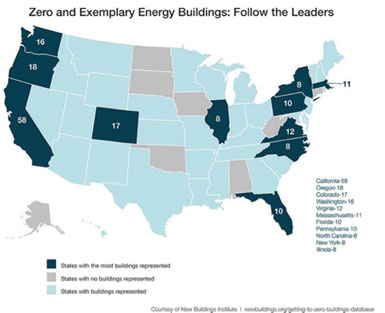If you’ve been wondering where the greenest buildings are – including net-zero energy – take a look at New Building Institute’s Getting to Zero Buildings Database.
So far, it includes 280 buildings in the US and Canada (and select projects elsewhere), in all climate zones and sizes, mostly office buildings (134) and schools (69), but also other types like wineries, nursing homes and courthouses. 37 are net-zero energy, all of which have at least a year’s worth of data that proves performance. There are also some notable community solutions, such as the Greensburg, Kansas Sustainable Master Plan.
"This new tool will be a boon for information sharing and will help speed the adoption of new thinking and technologies in green building," says Denis Hayes, who is behind the now-famous net-zero energy Bullitt Center in Seattle – the greenest office building in the world.
In the US, you’ll find buildings in 44 states, Washington DC and Puerto Rico.

Top 10 States
California – 58
Oregon -18
Colorado – 17
Washington – 16
Virginia – 12
Massachusetts -11
Florida – 10
Pennsylvania -10
Illinois -8
North Carolina -8
New York – 8
You can search the database by building type, size, location, efficiency level and retrofit vs. new construction. Each profile includes details on energy use, design features, and firms involved in the project.
Design teams and building owners can submit projects for the database, which will be evaluated for performance before being included.
Another tool is the 2030 Design Data Exchange, under development by American Institute of Architects and the Department of Energy. Architects will be able to easily enter data and anonymously compare their project performance with those in the AIA 2030 Commitment portfolio.
In August, architects around the world unanimously adopted the 2050 Imperative, which commits them to 100% net-zero energy design and construction by then.
Read our article, US Architects Move Steadily Toward Net-Zero Energy.
Here’s the Getting to Zero Buildings Database database:
